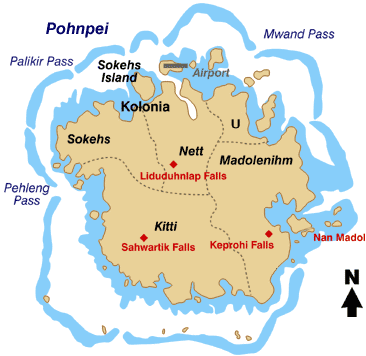The Federated States of Micronesia are located on the Caroline Islands in the western Pacific Ocean. The history of the modern Federated States of Micronesia is one of settlement by Micronesians; colonization by Spain, Germany, and Japan; United Nations trusteeship under United States-administered Trust Territory of the Pacific Islands; and gradual independence beginning with the ratification of a sovereign constitution in 1979.
The ancestors of the Micronesians settled there over 4,000 years ago. A decentralized chieftain-based system eventually evolved into a more centralized economic and religious Micronesian Empire centered on Yap and Pohnpei.Yap
| Pohnpei |
Nan Madol
Nan Madol offshore of Temwen Island near Pohnpei, consists of a series of small artificial islands linked by a network of canals, and is often called the Venice of the Pacific. It is located near the island of Pohnpei and was the ceremonial and political seat of the Saudeleur Dynasty that united Pohnpei's estimated 25,000 people until its centralized system collapsed amid the invasion of Isokelekel. Isokelekel and his descendants initially occupied the stone city, but later abandoned it.European colonization
European explorers - first the Portuguese in search of the Spice Islands (Indonesia) and then the Spanish - reached the Carolines in the 16th century, with the Spanish establishing sovereignty.Spain sold the islands to Germany in 1899 under the terms of the German–Spanish Treaty of that year.
Yap was a major German naval communications center before the First World War and an important international hub for cable telegraphy. It was occupied by Japanese troops in September, 1914, and passed to the Japanese Empire under the Versailles Treaty in 1919 as a mandated territory under League of Nations supervision. US commercial rights on the island were secured by a special US-Japanese treaty to that effect, concluded on February 11, 1922.
Empire of Japan
During World War I, many of the Germany possessions in the Pacific were conquered by Japan, who fought on the side of the Allies of World War I and was active in the Asian and Pacific theatre of World War I.The Empire of Japan administrated the islands from 1920 under the South Pacific Mandate granted by the League of Nations. During this period, the Japanese population grew to over 100,000 throughout Micronesia, while the indigenous population was about 40,000. Sugar cane, mining, fishing and tropical agriculture became the major industries.
In World War II, Japanese-held Yap was one of the islands bypassed in the U.S. "island-hopping" strategy, although it was regularly bombed by U.S. ships and aircraft, and Yap-based Japanese bombers did some damage in return. The Japanese garrison comprised 4,423 Imperial Japanese Army men under the command of Colonel Daihachi Itoh and 1,494 Imperial Japanese Navy men. A significant portion of the Japanese fleet was based in Truk Lagoon. In February 1944, Operation Hailstone, one of the most important naval battles of the war, took place at Truk, in which many Japanese support vessels and aircraft were destroyed.
World War II brought an abrupt end to the relative prosperity experienced during Japanese civil administration. By the War's conclusion most infrastructure had been laid waste by bombing, and the islands and people had been exploited by the Japanese military to the point of impoverishment.
Trusteeship
The United Nations created the Trust Territory of the Pacific Islands (TTPI) in 1947. Pohnpei (then including Kusaie), Truk, Yap, Palau, the Marshall Islands and the Northern Mariana Islands, together constituted the TTPI. The United States accepted the role of Trustee of this, the only United Nations Trusteeship to be designated as a "Security Trusteeship", whose ultimate disposition was to be determined by the UN Security Council. As Trustee the US was to "promote the economic advancement and self-sufficiency of the inhabitants."Independence
On May 10, 1979, four of the Trust Territory districts ratified the Constitution of the Federated States of Micronesia. The neighboring trust districts of Palau, the Marshall Islands, and the Northern Mariana Islands chose not to participate. The Honorable Tosiwo Nakayama, the former President of the Congress of Micronesia, became the first President of the FSM and formed his Cabinet. The FSM signed a Compact of Free Association with the U.S., which entered into force on November 3, 1986, marking Micronesia's emergence from trusteeship to independence. Under the Compact, the U.S. has full authority and responsibility for the defense of the FSM. This security relationship can be changed or terminated by mutual agreement. The Compact provides U.S. grant funds and federal program assistance to the FSM. Amended financial assistance provisions came on-line in FY 2004. The basic relationship of free association continues indefinitely.Trusteeship of the islands ended under United Nations Security Council Resolution 683, passed on December 22, 1990. The Compact was renewed in 2004.

